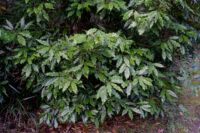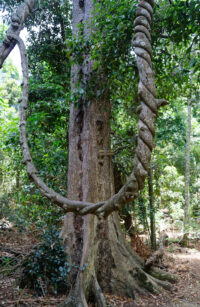Pronunciation: Argyrodendron (ar-jir-o-DEN-dron) trifoliolatum (tri-foe-leeoh-LAH-tum)
Argyrodendron trifoliolatum, commonly known as the white booyong or brown tulip oak, is a large rainforest tree native to eastern Australia.
Known for its buttressed roots that provide additional stability and support for growth in dense forest environments.
Taxonomy:
- Family: Malvaceae
- Genus: Argyrodendron
Description:
- Growth: Large tree, over 40m, bark is typically smooth and gray-brown, often developing shallow fissures as it matures.
- Leaves: Trifoliate (three-leaflet) leaves, with each leaflet being oval, smooth-edged, and dark green on top while pale underneath.
- Flowers: Small, pale yellow to creamy white flowers arranged in panicles, which bloom in late spring to early summer.
- Seed: Fruit is a capsule with winged seeds.
Habitat and Distribution:
Predominantly found in Queensland and New South Wales. Thrives in subtropical and tropical rainforests, particularly along fertile riverbanks and other moist, well-drained forest areas.
Hosts: (included but not limited to)
- Bird’s Nest Fern (Asplenium australasicum): Attaches to the branches where it collects leaf litter and moisture in its fronds, benefiting not only itself but other plants and small animals.
- Lichen (Parmeliaceae family): This diverse group of lichen species often grows on the trunk and branches. They help retain moisture on the bark’s surface and provide tiny habitats for invertebrates, which in turn support small predators like spiders.
- Grey-Headed Flying Fox (Pteropus poliocephalus): Roosts in the tall canopy, especially where fruiting plants are abundant.
- Sulphur-Crested Cockatoo (Cacatua galerita): Use the branches for perching and sometimes for nesting. They are known to strip bark and break off twigs, which may seem destructive but actually aids in the natural pruning and decomposition processes of the forest.
- Tree Frogs (Litoria spp.): Make their homes in the leaf litter around the base or within the damp crevices of its buttressed roots. By residing near the tree, they help control insect populations and serve as prey for larger predators, contributing to the food web dynamics around the tree.
Ecology and Uses:
- Timber: Valued for its durability and fine grain, though it is softer than many other hardwoods, making it suitable for furniture and interior fittings.
- Horticulture: Due to its impressive size, beautiful canopy, and distinctive buttressed roots.
- Canopy Structure: Forms part of the upper rainforest canopy, creating shade and regulating light levels below, which supports the diverse array of understory plants.
- Water Cycle Influence: Extensive root system help regulate the rainforest’s water cycle by capturing rainfall, reducing surface runoff, and helping retain soil moisture.
Links:
Argyrodendron trifoliolatum : Booyong | Atlas of Living Australia



